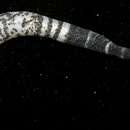Classification
(
anglais
)
fourni par World Register of Marine Species
The early history of the classification of Sipuncula within Animalia is summarized by Saiz-Salinas (2018). Their placement has varied, including a period in the Gephyrea, an amalgamation of unrelated groups introduced by Quatrefages. Ranking as an independent phylum was only gradually adopted from the 1900s. Sipuncula are currently downranked to an order within Annelida after molecular evidence over a number of years that Sipuncula are a group within Annelida (summarized in Schultze et al, 2019, Handbook of Zoology), with the following families. Family Antillesomatidae Kawauchi, Sharma & Giribet, 2012 Family Aspidosiphonidae Baird, 1868 Family Golfingiidae Stephen & Edmonds, 1972 Family Phascolosomatidae Stephen & Edmonds, 1972 Family Siphonosomatidae Kawauchi, Sharma & Giribet, 2012 Family Sipunculidae Rafinesque, 1814 Schultze et al (2019) recognized a classification structure within Sipuncula as six families without further division (no higher ranks than family), but are undecided on how to include the group within phylum Annelida, evidently rejecting a grouping with Amphinomidae, but outside of Polychaeta. When Sipuncula was ranked as an independent phylum the higher groupings of valid families was excessively partitioned as follows with two classes and three orders for just six families: Class Phascolosomatidea Order Aspidosiphonida [superfluous order for 1 valid familly] Family Aspidosiphonidae Baird, 1868 Order Phascolosomatida Family Antillesomatidae Kawauchi, Sharma & Giribet, 2012 Family Phascolosomatidae Stephen & Edmonds, 1972 Class Sipunculidea [superfluous class for 1 valid order] Order Golfingiida Family Golfingiidae Stephen & Edmonds, 1972 Family Siphonosomatidae Kawauchi, Sharma & Giribet, 2012 Family Sipunculidae Rafinesque, 1814
- 10. Heydenrych, B.J., Cowling, R.M. and Lombard, A.T. (1999) Strategic conservation interventions in a region of high biodiversity and high vulnerability: a case study from the Agulhas Plain at the southern tip of Africa. Oryx, 33: 256 - 269.
- 5. BirdLife International (October, 2007) http://www.birdlife.org/datazone/ebas/index.html?action=SpcHTMDetails.asp&sid=4028&m=0
- 5. Gasc, J-P. (1997) Atlas of Amphibians and Reptiles in Europe. Societas Europaea Herpetologica, Bonn, Germany.
- licence
- cc-by-4.0
- droit d’auteur
- WoRMS Editorial Board

